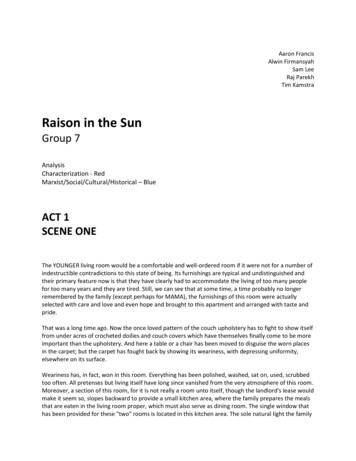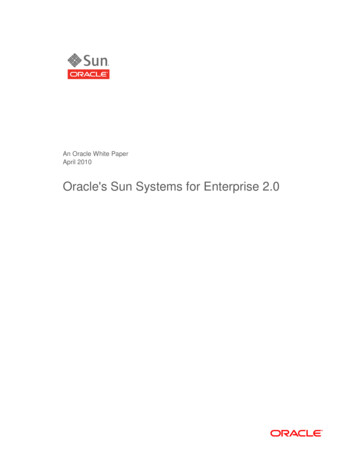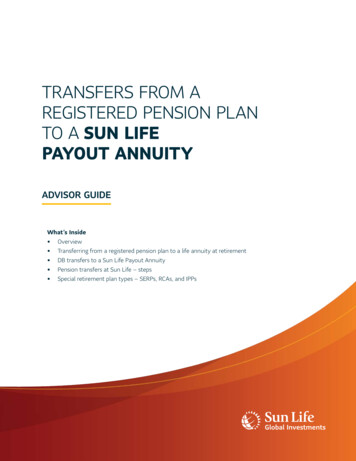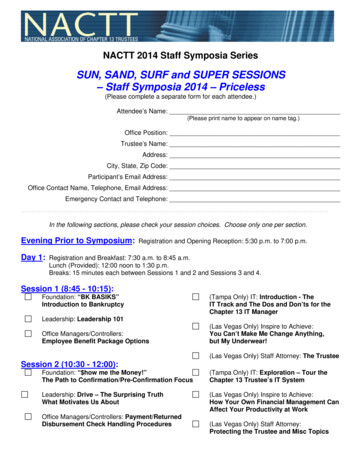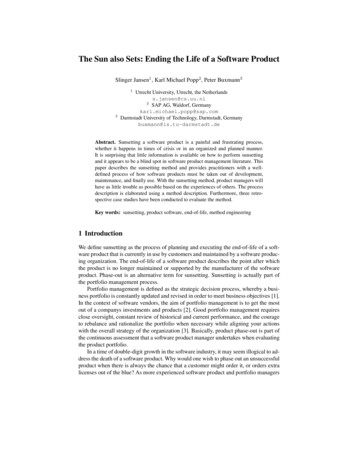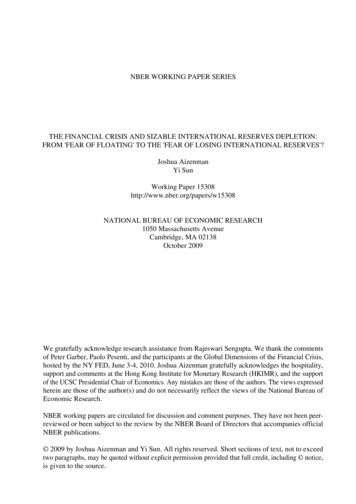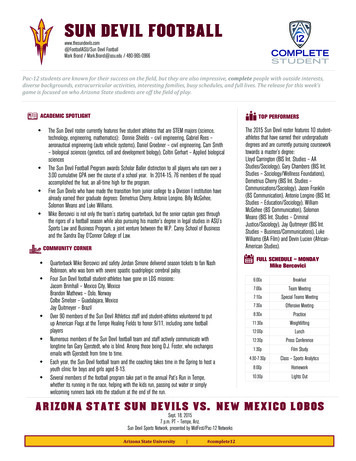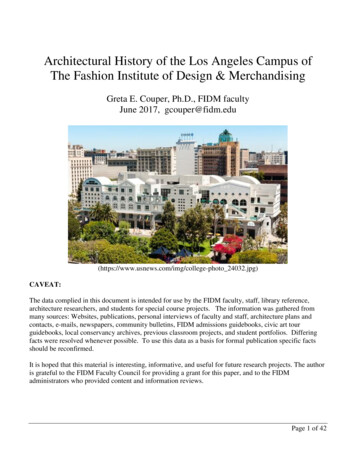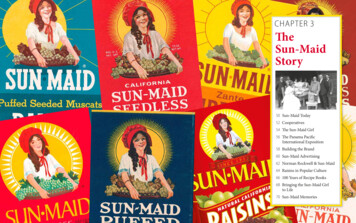
Transcription
CHAPTER 3TheSun-MaidStory50 Sun-Maid Today52 Cooperatives54 The Sun-Maid Girl56 The Panama PacificInternational Exposition58 Building the Brand60 Sun-Maid Advertising62 Norman Rockwell & Sun-Maid64 Raisins in Popular Culture66 100 Years of Recipe Books68 Bringing the Sun-Maid Girlto Life70 Sun-Maid Memories
50 the sun-maid storysun-maid today 51Sun-Maid TodaySince its beginning in 1912, Sun-Maid hasbeen serving American families and the world.The company experienced interruptions inexports to Europe during World War I, andto the world during World War II. Today,global trade distributes Sun-Maid boxesand packages to over 50 countries.SUN-MAID HEADQUARTERSOpened in 1964, the Kingsburg plantwas recognized then as one of America’stop new plants by Factory Magazine.The 640,000-square-foot, state-of-theart facility sits on more than 100 acres,20 miles south of Fresno. The facilityis continuously improving to meet thedemand of customers around the world.FOCUS ON FAMILYSun-Maid offers products that appealto customers of all ages and haspartnered with movie and animationstudios for family-friendly consumerpromotions.WORLDWIDESUCCESSSun-Maid is one ofthe world’s most recognizedbrands. Sun-Maid enjoyspreferred ingredient supplier statuswith many domestic and internationalfood-processing companies.PRODUCT LINESun-Maid offers a full lineof dried-fruit products thatinclude raisins and driedfruits, chocolate and yogurtfruits, raisin breads, andbaking mixes. Sun-Maidalso offers its products inbulk as ingredients for foodmanufacturers.VISITORs WELCOMETravelers are always welcome at theSun-Maid plant. Just off Highway 99in Kingsburg, California, visitors canview the world’s largest raisin boxand stock up on raisin and dried fruitsouvenirs at the Sun-Maid Store.ADVERTISINGThroughout Sun-Maid’s history, uniqueadvertising has made it one of theworld’s most recognizable and trustedbrands. Through television, printmedia, websites and social networks,promotional products, and recipe books,the Sun-Maid line of products reachesout to consumers worldwide.
52 the sun-maid storyCooperativesBeginning in Europe as the industrial revolution rapidlytransformed society and business, the 1844 establishment of theRochdale Equitable Pioneers Society in England provided the basisfor the growth of the modern cooperative movement.Sun-Maid cooperative principles allow members to gain throughcooperation, sharing in the cooperative’s marketing efforts andbenefiting from reduced processing and manufacturing coststhrough economies of scale. Education and technical supportassists growers in their own operations, and the democratic processenables self-governance.Many well-known brands function as cooperatives, includingagricultural cooperatives Sunkist Growers, Blue Diamond Growers,Sunsweet Growers, Ocean Spray Cranberries, and Land O’Lakes.Other cooperative organizations include utility cooperatives,supply cooperatives, and credit unions, as well as others includinginternational hotel chain Best Western and the consumers’cooperative Recreational Equipment Incorporated, or REI.Applied to the raisin industry, advantages of the cooperativeinclude reliability, product control from field to end user, growershaving a financial interest in keeping customers satisfied, and theability to put a face to family farming.A MEETING OF MINDSIn 1912, a group of California raisin growers created the California AssociatedRaisin Company, which became Sun-Maid Growers of California. The neworganization was intended to combat low prices and fluctuating demand, and toprovide better economies of scale in processing, selling, and creating stable markets.THE RAISIN KINGSeveral early attemptsto organize growersfailed, in part becauseof the rapid growthof the raisin industry.Developer MartinTheodore Kearneyproposed poolingresources to improve marketing and distribution. Hisideas and leadership gained his election as presidentof the California Raisin Growers’ Association, whichwas formed in 1895 and incorporated in 1899. Afterinitial success, difficult years followed with theAssociation’s demise in late 1905.ARMORY HALLIn November 1912, Fresno’s Armory Hall served as the site forthe organizational meetings of the California Associated RaisinCompany, which later became Sun-Maid Growers of California.Armory Hall (foreground) and the Barton Opera House (locatedat far right) were built in 1889 by vineyardist Robert Barton.SUN-MAID CITYBy 1918, the booming raisin business needed a newhome. Sun-Maid opened a state-of-the-art factory neardowntown Fresno. Upon its opening, Sun-Maid Citywas dubbed the “finest factory building west of Detroit.”MARKETING TO AMERICAIn 1915, the Cooperative hired a national sales team tomarket raisins directly to grocers. This effort, in conjunctionwith the introduction of the new Sun-Maid brand, printadvertisements, and recipe booklets, significantly increasedAmerica’s raisin consumption.
54 the sun-maid storyThe sun-maid girl 55The Sun-Maid GirlMany people want to know if a real person was the original “Sun-MaidGirl.” The answer is “Yes,” and her name was Lorraine Collett (Petersen).In May 1915, San Francisco was still recovering from its 1906 earthquakeand celebrated its rebirth by welcoming the international community tothe Panama Pacific International Exposition. Lorraine Collett attendedthis event with a number of other girls as representatives ofthe recently formed California Associated Raisin Company, laterSun-Maid Growers of California.Top StoryThis photograph of Lorraine (far right)appeared in the San Francisco Bulletinin 1915 and promoted Sun-Maid’sactivities at the Exposition.At the ExpositionThe Sun-Maid girls handed out raisin samplesto visitors of the Panama Pacific InternationalExposition while wearing white blouses with bluepiping and originally BLUE sunbonnets.Lorraine CollettAs Lorraine would later tell, “It was only after we returned toFresno that I was seen by Sun-Maid executive Leroy Paynewearing my mother’s red bonnet in my backyard that thebonnet color was changed from blue to red, because redreflected the color of the sun better.”The First PaintingWhile working at the Expo in San Francisco, Collettposed at the Post Street studio of artist Fanny Scaffordin the morning, then spent the rest of the day workingthe Expo, where the Sun-Maid girls were by then allwearing RED bonnets. The artist experimented witha variety of positions and props, finally settling on theiconic pose with an overflowing tray of grapes and aglowing sunburst in the background.The RedBonnetIn 1915, life wasmuch simpler,more rural, andsunbonnets werestill part of women’sfashion in California.Lorraine kept her originalred bonnet carefully folded ina dresser drawer from 1915 until shegraciously presented it to Sun-Maidin a small ceremony in 1974.The Original Sun-MaidAfter the Exposition, Miss Collettdid further modeling andappeared in the 1916 CecilB. DeMille film Trail of theLonesome Pine. LorraineCollett Petersen, as she wasknown after marrying, laterbecame a nurse and untilher death at the age of 90,continued to make specialappearances as the originalSun-Maid Girl.A National TreasureIn celebration of Sun-Maid’s 75th anniversary,the treasured original sunbonnet, by thenfaded pink, was donated to the SmithsonianInstitution in Washington, D.C. on January26, 1988, in the presence of U.S. Secretary ofAgriculture Dick Lyng.
56 the sun-maid storyThe panama pacific international exposition 57The Panama Pacific International ExpositionIn 1915, San Francisco hosted the Panama Pacific International Exposition, which celebrated the completion ofthe Panama Canal and the host city’s recovery efforts following a devastating earthquake and fire in 1906. FromFebruary to December of 1915, visitors were treated to grand buildings and displays among statues, murals,fountains, lakes, and gardens, including a working model of the Panama Canal and a replica of the GreekParthenon. Attractions showcased the greatestarts, transportation, machinery, and agricultureof the time—and Sun-Maid had its own exhibit.The exposition lasted nine months and Sun-Maid’swide exposure there helped launch the brand toworldwide recognition.THE CALIFORNIA BUILDINGSun-Maid, then known as the California AssociatedRaisin Company, had its display in the Californiabuilding within the Exposition’shorticultural palace. OtherExposition attractionsincluded exhibits,performances, andparades from countriesaround the world, aswell as Americanstates, counties,and businesses.A City ShowcasedIt took three years to construct the 630-acre fairgrounds,which were built on more than 70 cleared city blocks andfilled-in mud flats at the northern part of San Francisco,now known as the Marina. The buildings, which weremade only to lastfor the year of theExposition, wereconstructed ofwood and coveredwith plaster andburlap fiber thatcould be moldedand sculpted.Raisin SeederSun-Maid’s raisin seeder in the horticultural palacewas such a popular attraction that a second raisinseeder was added in the food products palace. As partof the live demonstration, Muscat raisins with seedswere placed into the machine, and instantly, seededraisins came out to be enjoyed by Exposition visitors.The First Sun-Maid GirlsAt the start of the Exposition, Lorraine Collett had yet topose for the now-famous watercolor that would becomeSun-Maid’s logo. Throughout the Exposition, Collett(pictured second from right) served with other youngwomen as raisin ambassadors, passing out samples ofraisins to visitors.IN THE NEWSThe Fresno Morning Republican reported onExposition events and encouraged local residents toattend special celebrations including Fresno CountyDay in March, 1915. In turn, the Exposition’sFresno County visitors participated in parades andgiveaways of raisins and raisin bread to encourageExposition visitors to attend Raisin Day festivitiesheld in April, 1915 in Fresno.The Palace of Fine ArtsThe Palace of Fine Arts is the onlyremaining building from the 1915Exposition. With assistance fromSun-Maid, the 2010 Campaign forthe Palace of Fine Arts worked toretrofit the building and preserve it forfuture generations. Today, Sun-Maid’sparticipation in the 1915 Exposition isfeatured in one of six new interpretativepanels surrounding the Palace.Sun-Maid SamplesThe Exposition attractedvisitors from around theworld, many who were onlyjust sampling raisins forthe first time. In additionto enjoying raisins, visitorscould view what was called a“stereomotograph,” a devicedisplaying 3’ x 3’ threedimensional scenes of raisingrowing and production inthe San Joaquin Valley.
58 the Sun-maid storybuilding the brand 59Building the BrandSince 1912, advertising had been the key to Sun-Maid’ssuccess. Almost immediately, ads featured in newspapersand magazines quickly turned Sun-Maid into a nationallyrecognized brand.BEAR BRANDBefore it was Sun-Maid, raisinssold by the California AssociatedRaisin Company were packagedunder the Bear brand trademark,referencing the state’s Bear Flag.In 1914, advertising managerE. A. Berg originated theSun-Maid brand name. Inspiredby the natural sun-dried raisinprocess, he adapted the slogan“made in the sun” to Sun-Maid.THE RAISIN TRAINThe first major advertisingcampaign was created when a trainloaded with 1,250 tons of raisinsheaded to Chicago, festooned withsigns reading “Raisins Grownby 6,000 California Growers.”For 2,000 miles, the Raisin Trainpiqued the country’s interest inboth raisins and California.THE SUN-MAID BRANDBy the early 1920s, the California Associated RaisinCompany’s membership comprised 85 percent of the state’sraisin growers. The organization changed its name toSun-Maid Growers of California in 1922 to identify moreclosely with its nationally recognized brand.RAISIN RECIPESSun-Maid created interest in raisins with print ads in nationalpublications. The repeated message touted the sweet, simplepurity of the raisin and its health benefits. Recipes for raisinbread and raisin pies promoted home baking, and promptedpeople to ask for these products at their local bakeries, which inturn increased sales from wholesale buyers.ANITA KINGAn actress, stunt-car driver, and the first womanto drive alone across America, Anita King wasa well-known celebrity in 1915 when she visitedFresno to participate in a Sun-Maid advertisingcampaign. Dressed in a Sun-Maid red bonnet,Miss King sat for photos, ate raisin pie, and rodethrough town in a fire engine.RAISIN DAYFresno held its first Raisin Day Parade onApril 30, 1909. The event was a huge successand drew 100,000 people. Visitors enjoyedcontests, races, performances, and the parade,which boasted float entries from communitygroups, businesses, townships, and counties as faraway as Los Angeles, and became an annual event.1915The Association beganusing the “Sun-Maid”brand name and thepainting of LorraineCollett (and when latermarried, Lorraine CollettPetersen).1923The original image of theSun-Maid Girl was modifiedfor the first time, givingher a bigger smile, brightercolors, and a stylized sun.This more contemporarylook kept her in style withthe rapidly changing 1920s.1956In the mid-1950s, thetrademark was updatedfor the second time. Thesun was moved off-center,intensifying the effect of thesunshine with the bonnetcasting a shadow across theSun-Maid Girl’s face.1970Brighter colors and ageometric sun modernizedthe logo’s third update,with the brand’s name nowprinted in yellow, giving awarmer, sunnier feel. ThisSun-Maid Girl continuedinto the 21st century.
60 the sun-maid storysun-maid advertising 61Sun-Maid AdvertisingTHE CARTON CANThe freshness of Sun-Maid raisins became thefocus of new packaging in 1980. The carton can’sairtight lid kept raisins plump and moist, and thelarger opening made it more consumer friendly.The package was an instant hit.Sun-Maid continued to expand its advertising strategiesinto the 1930s and beyond, keeping in step with fashions,popular culture, and technology. But regardless of themedium, Sun-Maid’s message of flavor and nutritionremained constant.DANCING RAISINSThe California Raisin Advisory Boardintroduced the California DancingRaisins in 1986. Images on lunchboxes,notebooks, clothing, posters, toys, andvideo games earned the CaliforniaRaisin Advisory Board considerablelicensing royalties.THE LADIES’ HOME JOURNALPublished since 1883, the Ladies’ Home Journal chronicledAmerican life from the woman’s perspective, covering family,marriage, work, home, and beauty issues. Sun-Maid targeted thisaudience by promoting healthy, sweet raisins for home cooking.DOUBLE-DECKERWith bus transportation being a common mode oftransportation, Sun-Maid capitalized by advertising inLondon, England, circa 1932. More raisins were consumedper capita in England thananywhere else, and theBritish helped to popularizethem around the world.SATURDAY EVENING POSTThe most widely circulated publication of its time,the Saturday Evening Post appealed to Americawith its high-quality art, short stories, essays,serialized novels, jokes, cartoons, and poetry. Thisad from 1940 depicts raisins used at home, andtheir appeal to soldiers overseas, who welcomedthe non-perishable taste of home.KID APPEALThe natural appeal of raisinsto children has been usedconsistently in Sun-Maidadvertising. This ad promotesraisins as a healthful snack, aprecursor to the 1980s “Nature’sCandy” marketing campaign.Photograph by Ansel Adams: 2011 The Ansel Adams Publishing Rights Trust.SWEET BY NATUREA series of televisionand print ads ranin the 1990s withchildren as Sun-Maidspokespersons. Theads became one ofSun-Maid’s best-lovedcampaigns.CELEBRATINGYOSEMITESun-Maid celebratedYosemite NationalPark’s centennialanniversary in 1990with advertisingthat showcasedAnsel Adams’ 1960photograph Moonand Half Dome.Sun-Maid was thefirst food companyto receive permissionto use an image fromthe Ansel AdamsPublishing RightsTrust in connectionwith advertising andpromotions.STAR POWERIn 2006, the Sun-Maid Girl was animated for the firsttime. Her 21st-century image appeared in print, ontelevision, and on the company’s website to launchthe new slogan, “Just Grapes& Sunshine .”
62 the Sun-Maid StoryNorman Rockwell & SUN-MAID 63Norman Rockwell & Sun-MaidDuring the 1920s, renowned artist Norman Rockwell created a series of advertisements which illustratedSun-Maid’s integral place in the traditional American household. These illustrations appeared in the leadingmagazines of the time, including Saturday Evening Post, Good Housekeeping, and Ladies’ Home Journal. As thegreatest commercial illustrator of his time, Rockwell’s illustration technique was theinspiration behind bringing the Sun-Maid girl to life in 2006.celebrating sun-maid’s 75thA collectible plate was produced tocommemorate Sun-Maid’s 75th anniversary in1987 featuring the painting Market Day Special.norman rockwellRockwell was born in NewYork city in 1894 and studiedart from the age of 14. Hebecame the art director ofthe Boy Scouts of Americapublication Boys’ Life whilestill in his teens. Duringhis career as a freelanceillustrator, Rockwell painted322 covers for the SaturdayEvening Post in addition toproducing work for Life,Literary Digest, CountryGentleman, and Look.Rockwell lived in the NewEngland town of Arlington,Vermont, for years until a firein 1943 destroyed his studio,along with many paintings. He later moved to Stockbridge,Massachusetts, where he lived until his death at the age of 84.A trust put his art and archives into what would become theNorman Rockwell Museum and his last studio, a red barnlike structure, was moved to the museum grounds in 1986. Acelebration to mark the 100th anniversary of Rockwell’s birthwas held from 1994–1995 at the Norman Rockwell Museumin Stockbridge, Massachusetts. During the celebration, twooriginal oil paintings commissioned by Sun-Maid (MarketDay Special and Fruit of the Vine) were loaned to themuseum, where they remain today.in a wonderful bargain bagPainted in 1927, In a Wonderful BargainBag measures 30 x 28 inches (76 x 71cm)and features Sun-Maid’s blue “Market DaySpecial” bag.marketdayspecialThe 1927paintingMarketDay Specialmeasures35 x 33 inches(89 x 84cm)and featuresSun-Maid’seconomical4-pound raisinpackage.Picture credits: top left: Norman Rockwell entering his South Street, Stockbridge, Massachusetts, studio, 1966. Photo by Louie Lamone. Norman Rockwell Museum Collections. NRELC: Niles, IL.bottom right: Norman Rockwell’s original Stockbridge studio (exterior). Photo by Art Evans. Norman Rockwell Museum.fruit of the vinePainted in 1926, Fruit of the Vinemeasures 31 x 27 inches (78.5 x68.5cm) and features Sun-Maid’s bluemuscat raisin box. In a 1967 lettersent from Norman Rockwell toSun-Maid, Rockwell explainedthat the elderly woman in thepainting was the mother of his firstwife. Rockwell often used familymembers and people from hiscommunity as subjects in his work.little rebelscan’t hold outPainted in 1928, Little Rebels Can’tHold Out was used in a print adappearing in The Farmer’s Wife. Asin all of his commercial illustrations,Rockwell downplayed the product’sprominence and focused on theinteraction between generations.the more raisins thebetter the puddingThe More Raisins the Better the Puddingwas painted in the 1920s and used in aSaturday Evening Post advertisement.The painting, measuring 33 x 47 inches(84 x 119cm) was used to featureSun-Maid raisins in puddings in40,000 grocery stores.
64 the sun-maid storyRaisins inPopular CultureSun-Maid raisins not only hold a place in history,but also a place in the hearts of children andadults across the globe. Sun-Maid’s status as themost well-known and highly regarded name inraisins makes the brand a natural choice to befeatured in numerous forms of pop culture.Throughout the years, Sun-Maidproducts have appeared on earlymorning and late-night talk shows,and even featured in a MasterCard“Priceless” commercial as one of thenecessary items for building the bestsnowman on th
promotional products, and recipe books, the Sun-Maid line of products reaches out to consumers worldwide. PRODUCT LINE Sun-Maid offers a full line of dried-fruit products that include raisins and dried fruits, chocolate and yogurt fruits, raisin breads, and baking mixes. Sun-Maid also offers its

